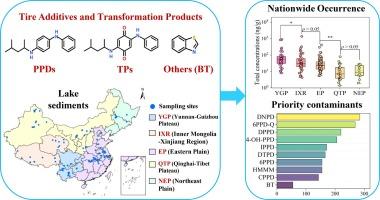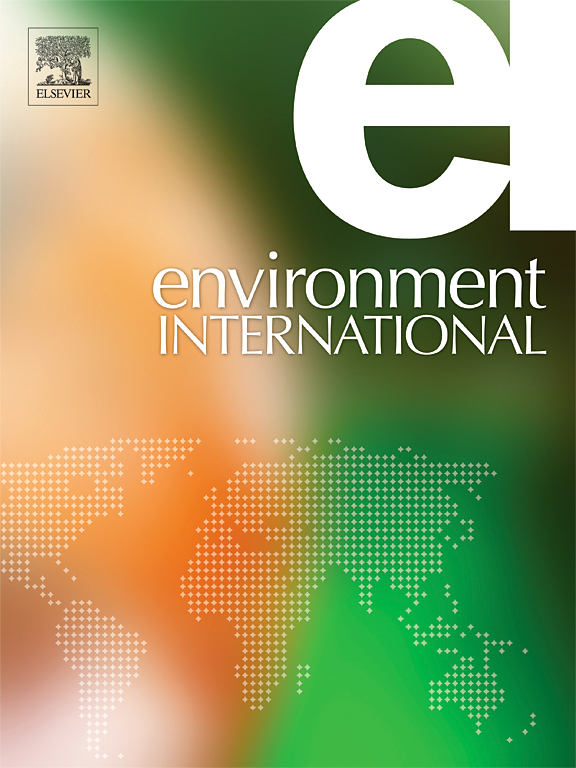Nationwide occurrence and prioritization of tire additives and their transformation products in lake sediments of China
IF 10.3
1区 环境科学与生态学
Q1 ENVIRONMENTAL SCIENCES
引用次数: 0
Abstract
As a group of emerging contaminants of global concern, tire additives and their transformation products (TATPs) are causing a severe threat to aquatic ecosystems, particularly the highly lethal effects of N-(1,3-dimethylbutyl)-N’-phenyl-p-phenylenediamine quinone (6PPD-Q) on certain fish species. Yet, the contamination status of TATPs in the lake ecosystems remains largely uncharacterized. This study conducted the first nationwide monitoring of the distribution characteristics of TATPs in 208 lake sediments collected from five lake regions across China. All the 13 TATPs were identified in lake sediments, with the total levels varying between 1.4 and 1355 ng/g, and 4-hydroxydiphenylamine (4-OH-PPD) as the most dominant. The total levels of TATPs decreased in the following order: Yunnan-Guizhou Plateau > Inner Mongolia-Xinjiang Region, Eastern Plain > Qinghai-Tibet Plateau, and Northeast Plain (p < 0.05). The geographical distribution of TATPs in lake sediments was significantly driven by total organic carbon content, temperature, and population density. N,N’-di-2-naphthyl-p-phenylenediamine, 6PPD-Q, N,N′-diphenyl-p-phenylenediamine, and 4-OH-PPD belonged to high-priority contaminants. Our study emphasizes that emerging pollutant TATPs place significant pressure on lake ecosystems and deserve urgent attention.


中国湖泊沉积物中轮胎添加剂及其转化产物的全国性出现及优先级排序
作为一类全球关注的新兴污染物,轮胎添加剂及其转化产物(TATPs)正在对水生生态系统造成严重威胁,特别是 N-(1,3-二甲基丁基)-N'-苯基-对苯二胺醌(6PPD-Q)对某些鱼类物种的高度致命影响。然而,TATPs 在湖泊生态系统中的污染状况在很大程度上仍未得到描述。本研究首次在全国范围内对从五个湖区采集的 208 个湖泊沉积物中的 TATPs 分布特征进行了监测。在湖泊沉积物中发现了全部 13 种 TATPs,总含量介于 1.4 至 1355 ng/g 之间,其中以 4-羟基二苯胺(4-OH-PPD)的含量最高。TATPs 的总含量依次下降:云贵高原、内蒙古-新疆地区、东部平原、青藏高原和东北平原(p < 0.05)。湖泊沉积物中 TATPs 的地理分布明显受总有机碳含量、温度和人口密度的影响。N,N'-二-2-萘基对苯二胺、6PPD-Q、N,N′-二苯基对苯二胺和4-OH-PPD属于高优先级污染物。我们的研究强调,新出现的污染物 TATPs 对湖泊生态系统造成了巨大压力,亟需引起关注。
本文章由计算机程序翻译,如有差异,请以英文原文为准。
求助全文
约1分钟内获得全文
求助全文
来源期刊

Environment International
环境科学-环境科学
CiteScore
21.90
自引率
3.40%
发文量
734
审稿时长
2.8 months
期刊介绍:
Environmental Health publishes manuscripts focusing on critical aspects of environmental and occupational medicine, including studies in toxicology and epidemiology, to illuminate the human health implications of exposure to environmental hazards. The journal adopts an open-access model and practices open peer review.
It caters to scientists and practitioners across all environmental science domains, directly or indirectly impacting human health and well-being. With a commitment to enhancing the prevention of environmentally-related health risks, Environmental Health serves as a public health journal for the community and scientists engaged in matters of public health significance concerning the environment.
 求助内容:
求助内容: 应助结果提醒方式:
应助结果提醒方式:


